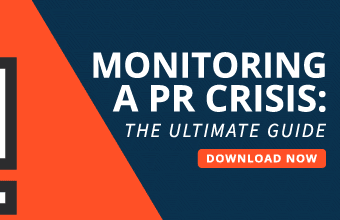In the past, dealing with a crisis meant strategically placing press releases, conducting damage control interviews, and hoping that traditional media would convey your message to the masses. It was like navigating a well-charted course where you had some control over the winds of public opinion.
However, in today’s interconnected world, social media platforms have become a breeding ground for the rapid dissemination of information—both true and false—often leading to a wildfire of speculation and opinion before the affected organizations even have a chance to respond. And suddenly, you find yourself in the eye of an internet firestorm, with a multitude of voices chiming in to demand answers, accountability, and action. The pressure mounts, the stakes rise, and your carefully crafted crisis management plan starts to resemble flimsy rafts in the face of a raging sea.
So how do you stay afloat? How do you come out unscathed and keep your reputation intact in the age of social media? That’s what we’ll be exploring in this blog. Read on to find the best practices for managing your online reputation in a world of ever-evolving technology and digital communication.

The power—and perils—of social media
Social media is a double-edged sword. On the one hand, it gives you unprecedented access to your audience, allowing you to engage with them directly and build genuine connections. But on the other hand, it can be a ruthless battlefield, where every misstep is magnified, every misjudgment is immortalized in screenshots, and every misinterpretation is capable of becoming a headline.
Plus, the online world’s insatiable appetite for controversy and scandal can quickly turn an isolated incident into a full-blown PR nightmare. One ill-advised tweet or a misinterpreted post can ignite a blaze of negative sentiment, leaving a trail of damaged reputations, dwindling customer trust, and financial repercussions.
But despite the perils, social media can also be a powerful tool for addressing challenging crises. With careful management and a strategic approach, social media can serve as a beacon of hope amidst the chaos. It can be the platform where crises are transformed into catalysts for growth, where authenticity and transparency prevail, and where brands can prove their mettle in the face of adversity.
Navigating crisis communication in the digital age
In the throes In the throes of a crisis, you’re suddenly thrust into the spotlight, and every move is scrutinized. The key is to be prepared and have a plan before you’re forced to make decisions in the heat of the moment. Here are some tips to ensure smooth sailing in the digital age of crisis management:
-
Use automation software to monitor social media
Harness the incredible might of automation software to keep a watchful eye on every mention and movement related to your brand. This ingenious tool will be your secret weapon, alerting you to sudden shifts in sentiment and empowering you to take proactive action. No need to assemble an army of resources to endlessly monitor your accounts – just set up the software, and you’re good to go. Also, don’t worry if coding isn’t your superpower. Simply seek out a reliable platform with a gentle learning curve and a no-code setup, so you can focus on the content of your response rather than the technical nitty-gritties.
-
Respond quickly and honestly
If there’s one thing social media has taught us, it’s that silence is not golden—it’s a one-way ticket to PR purgatory. When a crisis strikes, your audience needs to hear from you—and they need to hear from you right away. But don’t just respond for the sake of it. Today’s digitally savvy audience craves honesty and directness. Any attempts to evade or manipulate the truth can quickly backfire. And the last thing you want is to exacerbate the crisis by spreading misinformation or making false promises. So, take the time to verify facts before responding, and if necessary, provide updates as new information becomes available.
-
Be consistent with your messaging
Crises can often be long and drawn out, with multiple chapters unfolding over days or weeks. As the protagonist of your brand’s narrative, it’s crucial to maintain consistency throughout this challenging journey. Constantly changing your stance or contradicting yourself will only confuse your audience and chip away at your hard-earned credibility. Stick to a cohesive narrative that communicates your brand’s values and honors the truth. Doing so will also demonstrate that you fully grasp the situation and are working towards a resolution.
-
Host a webinar or a virtual event to address concerns directly
Sometimes words alone just don’t cut it. If your crisis involves complex concepts or has sparked a storm of debate, why not host a live webinar and confront the issue head-on? This is your chance to show that you’re not afraid to face the music and take ownership of the situation. Moreover, this medium will allow you to engage in a meaningful dialogue, addressing questions and concerns while showcasing your organizational values in action. To proceed, draft a comprehensive agenda outlining all the points of discussion and who will be speaking. Then, scout out a dependable webinar platform and spread the word via your social media channels.
-
Embrace the memes
One of the quickest ways to ease a tense situation is to inject a bit of lightheartedness into the discussion. And there’s no better way to do that than through the power of memes. Whether it’s a clever pun or an old-school internet classic, the right meme can humanize your brand and turn a potential PR disaster into an opportunity to demonstrate your wit and creativity. However, tread carefully and ensure your humor is sensitive, relevant, and aligned with your brand’s values. Remember, a well-placed meme can go viral and turn the tide of public opinion in your favor, but a poorly executed one can exacerbate the crisis and create a meme-storm of its own. So, channel your inner comedian cautiously.
-
Develop a project scope
In the midst of a crisis, it’s easy for PR professionals to get caught up in the whirlwind of digital chaos and lose sight of the bigger picture. Before you know it, things are spiraling out of control, and you’re left mired in a vicious circle of reactive damage control. Reduce this risk by creating an ironclad scope to guide your online crisis management project. This document should define clear goals and responsibilities, as well as a timeline of when to deliver on those targets. With a well-defined roadmap in hand, you can approach the treacherous waters of online reputation management with confidence, knowing that you have a solid plan to steer your brand towards calmer shores.
-
Learn from past mistakes
History has a nasty habit of repeating itself, but under the ever-watchful eye of the internet, this repetition can turn into a never-ending loop of embarrassment. Don’t let your brand become a recurring punchline. With the right strategies and mindset, you can prevent some of the same mistakes from happening again. After the initial dust has settled, take a step back and do a skills assessment of what worked and what didn’t. Make a note of any areas that could have been managed better, and use those learnings to build a comprehensive crisis communication plan that can be activated quickly and efficiently when the next storm looms on the horizon.
Mastering crisis communications in the age of social media
Gone are the days when crises could be discreetly handled behind closed doors, shielded from the prying eyes of the digital realm. No longer can organizations meticulously sculpt their narrative, carefully choosing their words to present a polished facade to the world.
Today, crisis communications require adaptability, transparency, and a deep understanding of digital dynamics. By embracing the best practices laid out in this article, PR pros can take charge of their organization’s online reputation and skillfully navigate the tempestuous waters of public opinion.








